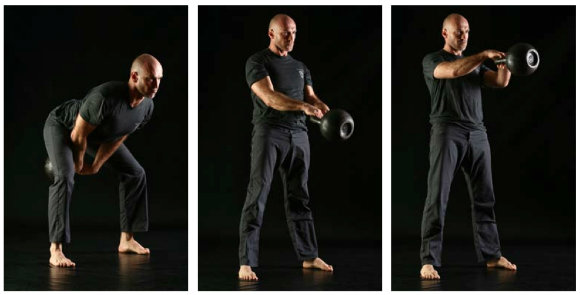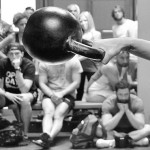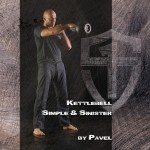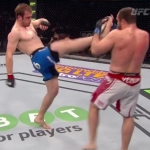If perfection is found when there is nothing more to take away, then Simple & Sinister is much closer to it than the program minimum from Enter the Kettlebell.
Swings and get-ups. Clear numbers, clear goals, a crystal-clear progression. Nothing to take away, but plenty of room to add other work to meet one’s goals.
Simple & Sinister is designed to augment an athlete’s primary training. It is designed to add strength and conditioning to the training regime of a martial artist, tactical operator, powerlifter, or other athlete. What about athletes who compete in kettlebell sport? Is Simple & Sinister a good fit for those athletes?

Hard Style vs. Sport-Style
A distinction is often made between hard style lifting and sport-style lifting. This distinction is often amplified by those who have no strong grasp of either style. Yes, they are different approaches to lifting kettlebells, but they are not contradictory or mutually exclusive.
In hard style lifting, the athlete applies maximum or near-maximum force to complete each lift. In sport-style lifting, the athlete applies just enough force to complete the rep, saving his energy for the next rep. And the next. And the one after that, for up to ten minutes.
There are differences in technique as well, in accordance with the different goals of the two styles of lifting. There is not a good style and a bad one, or safe and unsafe, or strong and weak. Just as a hard style karateka can benefit from practicing Judo, or a powerlifter may supplement his slow-grind deadlifts with explosive power cleans, sport-style lifters can benefit from hard style training. Depending on their goals, hard style lifters may find that sport-style lifting is beneficial for them as well.
The Qualities Needed for Kettlebell Sport
The question to ask about any assistance program is whether it will provide physiological qualities necessary and useful for one’s primary sport. What does a competitive girevik need? If I had to reduce it to a minimum, I’d say cardiovascular endurance, an explosive lower body, and a stable upper body.
Cleans, jerks, and snatches are powered by the legs and caught by the arms in the rack or overhead. The legs and hips are the prime movers. A strong core links the lower body to the arms for the pulls of the clean and snatch, and for the launch of the jerk. When the weight has been launched by the legs, it is caught by the arms in the lockout position. Explosive legs, stable shoulders, strong core. Lungs and heart that can handle the workload. Add grip endurance, and you have most of the physical qualities a competitive girevik needs.
What S&S Can Give the Kettlebell Sport Athlete
The staple movement in S&S is the heavy one-arm swing. I won’t give the program away here, but it calls for a high volume of one-arm swings in a short period of time, and encourages men to work up to a heavy kettlebell — 48k is the master plan.
Hard style one-arm swings build strong legs and hips that can extend explosively time and time again, just like the girevik needs for jerks, snatches, and cleans. Done in sufficient numbers, they build grip endurance. Simple & Sinister swings are harder and faster than anything most competitive kettlebell athletes will do on the platform. They make the legs stronger and faster. They carry over well to the more measured pace of competition lifting. They are to the girevik what sprinting is to the middle distance runner. When I’m doing S&S swings my heart rate regularly exceeds 186 beats per minute, and I’ll hit triple digit swing reps in under five minutes with a 32k bell. It makes long cycle with a pair of 24k bells seem almost easy. Almost.
The other movement in Simple & Sinister is the get-up. Again, the plan tells the athlete to go heavy and get strong, and to compress rest periods. The get-up restores tired shoulders and builds strength and stability overhead — just where the competitive girevik needs it. Snatches, jerks, and long cycle all require solid, stable lockouts. Many competitions are now electronically scored, so a solid, motionless lockout from the bells to the ground is more important than ever. If they wobble around, the lift does not count. Weak, inflexible shoulders lead to premature fatigue, inefficient technique, and lost reps. The get-up builds upper body stability, particularly through the shoulder girdle, which every lifter needs on the platform.
Explosive lower body power, flexible upper body stability, a grip that won’t let go, and a heart and lungs that keep driving. These are things the competitive kettlebell athlete needs, and Simple & Sinister delivers. I’ve found it to be a great addition to my sport training. Typically, I’ll do a five to seven minute set of long cycle clean and jerks with 2x24k, rest for less than five minutes, then the Simple & Sinister program with a 32k. All the benefits of both hard style and sport-style lifting, in under 25 minutes a day.
A Complete Kettlebell Sport Program
While Simple & Sinister can be a great addition to a competitive girevik’s arsenal, it should not be the only accessory work done. Practicing the competitive lifts builds the qualities needed for domination on the platform, and Simple & Sinister reinforces these qualities, but most top gireviks find they still need some steady-state cardio — running, rowing, biking, skiing — whatever floats your boat.
Twenty to twenty-five minutes seems to be the sweet spot — enough cardio to power you through a ten minute set on the platform, but not so much that you compromise strength and power gains. I recommend alternating steady state cardio and Simple & Sinister on days after sport-specific training, or incorporating steady-state cardio at least two days a week.





Excellent article!
I am currently preparing for my second Girevoy competition and am using S&S protocol at the same time. Having read your post gives me even more confidence in the appropriateness of such an approach.
I haven’t tried combining the Girevoy training with S&S on the same day, because it seemed like Girevoy sets took too long, and I like to keep my sessions to 30min tops, but seems like a shorter Girevoy set worked for you, so I will attempt to combine in a similar manner.
Thank you very much for sharing!
I would argue that tbe hs style swing ia actully not a great idea for kettlebell sport. Typically sport swinging is done heavier and for more reps (1 handed) with the faster contraction required for sport. It isnt seen the same way as hs because there simply isnt time for the dramatic hip extension at the top. Which is the problem with the hs swing for sport. Sport requires “just the lift” both psychologically and physically. Anything extenious to that robs the lifter of power (as opposed to strength) and will result in less weight for less time and fewer reps which is the antithesis of the sport
Hey Steve,
You make a convincing argument for combining your competition lift with S & S. I was wondering how it worked out for you. Could you improve or would you change something?
Great article! I too am a GS competitor (looking for my CMS with the 20kg LC). What do you consider “heavy” if I do compete and regularly use the 20kg kbs? I am a female in my 30s and have been competing for almost 3 years now. I also just started implementing the 24kg kb into my training but that weight still feels heavy. I’m thinking that’s the kb to use but I’m not sure.
Any insight would be appreciated.
wow pavel
Great article Steve!
Having competed in GS for the past few years and trained HS since ’10, I find the two methods extremely complimentary and each have unique benefits to any lifter.
Thanks, Rickard and Mike!
Great articles, there seems to be alot of them latley!
Great stuff Mr. Matthews!!